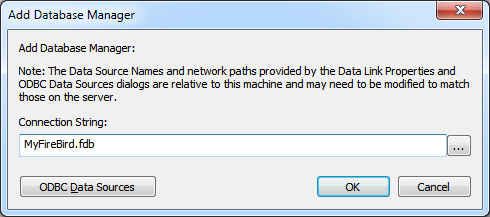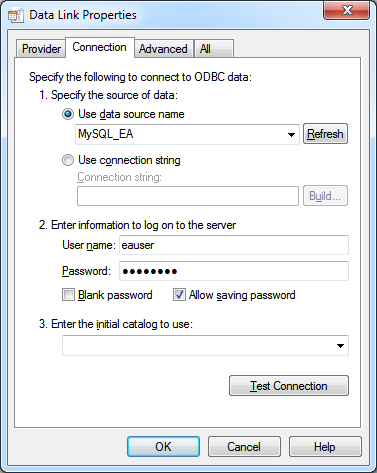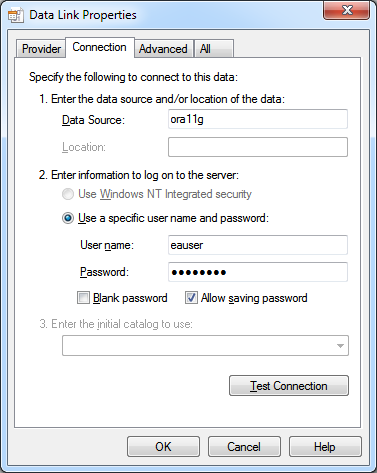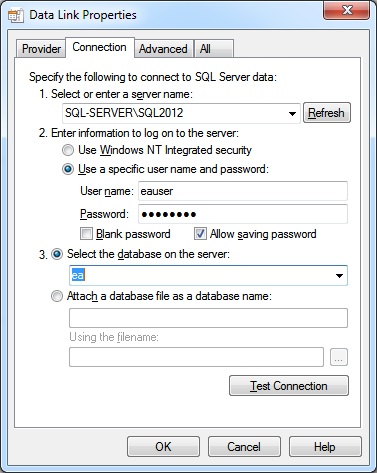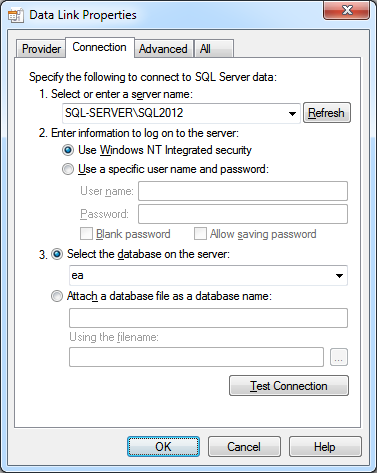Please note : This help page is not for the latest version of Enterprise Architect. The latest help can be found here.
Topic |
| Prev | Next |
Add Database Manager
The Add Database Manager screen displays when you click on the on the 'Sparx Systems Cloud Services Configuration Client' dialog; it helps you to define a new database connection to either a local Firebird repository or a DBMS repository (via ODBC or OLE/DB).
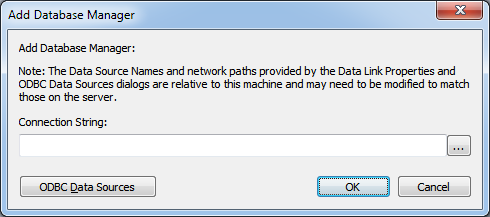
This note is shown on the Add Database Manager screen:
"Note: The Data Source Names and network paths provided by the Data Link Properties and ODBC Data Sources dialogs are relative to this machine and may need to be modified to match those on the server."
This means if the Cloud Services Client application is running from a remote machine (that is, not the Cloud Server) the screens that are shown by clicking on the  button and ODBC Data Sources button are relative to the current machine and not the Cloud Server, so care should be taken.
button and ODBC Data Sources button are relative to the current machine and not the Cloud Server, so care should be taken.
By default and as a safety precaution, whenever a new Database is defined it is automatically configured to be disabled. This can be changed by checking the 'Accept Queries' option on the Configure Database Manager screen.
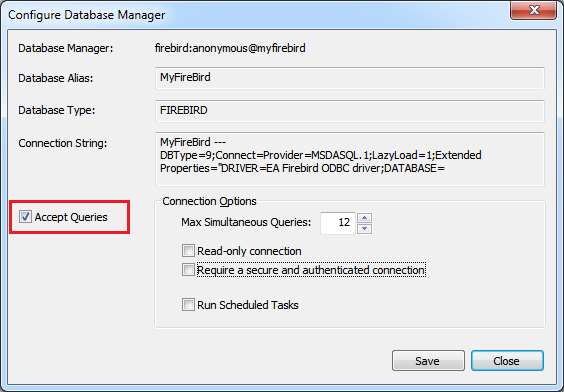
Adding New Databases
It is important to note that the Cloud Server uniquely identifies Databases by a single identifying value, this value is referred to as the 'Database Alias'. For:
- Firebird definitions the 'Database Alias' is the filename minus the extension
- ODBC based definitions the 'Database Alias' is the 'Data Source'
- Oracle OLE DB based definitions the 'Database Alias' is the 'net service name'
- SQLServer OLE DB based definitions the 'Database Alias' is the 'Initial Catalog'
Therefore careful consideration must be taken when defining database connections to ensure that duplicate 'Database Alias's are avoided. However if two or more database definitions share the same alias then all Enterprise Architect clients will connect to the first database found with the requested alias.
Item |
Description |
|---|---|
|
Firebird Database |
Sparx Systems, in the 'Introduction to Sparx Systems Cloud Services' webinar, demonstrate the Cloud Services with a Firebird database as it is so easy to set up and use, and it works extremely well with Sparx Systems Cloud service technology. Firebird is a free, open source rational database that runs on a variety of platforms. Firebird is very sophisticated and offers great concurrency, scalability and performance. It can be used in an enterprise setting and has been used in production systems, under a variety of names, since 1981. To discover more about the Firebird database, please visit the following website: http://www.firebirdsql.org/en/about-firebird/ You can view the webinar by clicking on this link: http://www.sparxsystems.com/resources/webinar/model-repository/cloud/introduction/introduction-cloud-services.html
You can define a connection to a Firebird database by entering its filename (and extension) only; for example,'MyFireBird.fdb'.
The Cloud Server assumes all Firebird databases physically reside under the directory %SERVICE_PATH%\Models\. Therefore, if the Cloud Server is installed to the default folder of: ...\Program Files (x86)\Sparx Systems\Cloud Services\ then all Firebird models will be located at: ...\Program Files (x86)\Sparx Systems\Cloud Services\Models\ |
|
ODBC Database |
You can define a connection to a DBMS Database by specifying the connection string to the database. If you are running the Management Client on the same machine as the server you can
Note 1: All ODBC DSNs need to be defined as SYSTEM DSNs because the Cloud Server runs as a Windows Service and User DSNs might not be available to the Cloud Server. Note 2: The step for filling in the user name and password might not be required if the user name and password have been saved with the ODBC DSN. |
|
Oracle Database (via OLE DB) |
You can define a connection to an Oracle Database (via OLE/DB) by specifying the connection string to the database. If you are running the Management Client on the same machine as the server you can - click on the - select provider 'Oracle Provider for OLE DB' and click 'Next >>' - enter the name of the 'Data Source', this is the Oracle 'net service name' as defined in the TNSNAMES.ORA - fill in the user name and password and check the 'Allow saving password'
Note: because the Cloud Server identifies databases by the 'Data Source' value and Oracle OLE DB defines the 'Data Source' as the 'net service name' it is only possible to access 1 Oracle repository per 'net service name'. The workaround to this limitation is to define multiple 'net service name' in TNSNAMES.ORA that differ only by name. |
|
SQLServer Database (via OLE DB using SQL Server authentication) |
Microsoft SQL Server supports two different forms of database authentication: 1. Windows NT authentication and 2. SQL Server authentication, The Cloud Service will work with either, but SQL Server authentication is easier to configure. Prior to defining the Cloud Service connection, you should define a SQL Server user with db_datareader and db_datawriter roles to the database that will act as the Enterprise Architect repository. You can define a connection to a SQLServer Database by specifying the connection string to the database. If you are running the Management Client on the same machine as the server you can:
|
|
SQLServer Database (via OLE DB using Windows authentication) |
Microsoft SQL Server supports two different forms of database authentication:
The Cloud Service will work with either, but Windows authentication requires some special consideration. The Cloud Server runs as a Windows Service, and by default all Windows Services run as 'Local System Account'; therefore, if Windows authentication is to be used the Sparx Systems Cloud Service should be configured to run under a predefined network user (configured with the Windows Services console) and this network user must have access rights to the database (configured with Microsoft SQL Server Management Studio or similar). You can define a connection to a SQLServer Database by specifying the connection string to the database. If you are running the Management Client on the same machine as the server you can:
Note: Because the Cloud Service is run under a single account, all database access will be performed under that account, so it will not be possible to keep track of what records are updated in the database by individual users. |
